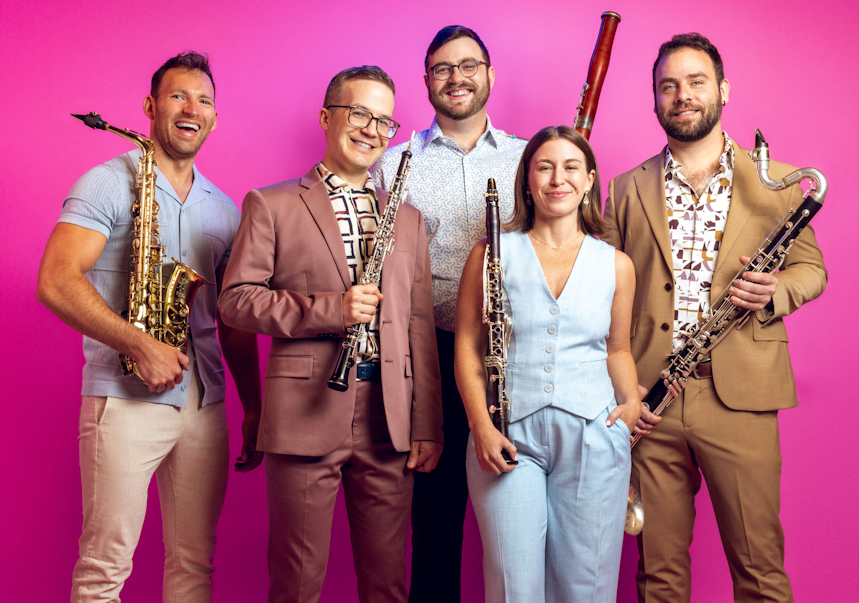Comprising five reed players and entrepreneurs unbounded by limits or categorization, the Grammy Award winning Akropolis Reed Quintet celebrates their 16th season as “a sonically daring ensemble who specializes in performing new works with charisma and integrity” (BBC Music Magazine).
The concert is followed by a reception where you can meet the artists.
All are encouraged to attend.
This concert is generously co-sponsored by
Walden Savings Bank
Ryan Lindveit (b.1994)
Venus of Willendorf (2024)
Oswald Huỳnh (1997)
These few specks of time (2023)
Derrick Skye (b.1982)
A Soulful Nexus (2023)
George Gershwin (1898-1937)
An American in Paris (1928) arr. Raaf Hekkema
Program Notes, provided by the Akropolis Reed Quintet
Venus of Willendorf (2024) — Ryan Lindveit (b. 1994)
From the composer:
I first learned about the Venus of Willendorf, a 30,000-year-old, 4.4-inch carved limestone figure found in Austria, in an art history class in 2014, and so it was with tremendous sense of anticipation and excitement that I approached visiting the Natural History Museum Vienna, where the figure is currently exhibited, ten years later. In the same spirit of joyful enthusiasm, I composed Venus of Willendorf for the Akropolis Reed Quintet, a group of musicians who eagerly tackle every musical challenge with artistry and aplomb. The origins of the Venus figurine are mysterious, as is its meaning, though some scholars theorize that it is associated with fertility, growth, and vitality. In response to this theory, I composed exuberant and vigorous music for these talented musicians. Additionally, the Venus is both quite tiny and amply voluptuous, so I often simultaneously feature high notes in the oboe with low notes in the bass clarinet to reflect metaphorical mappings of high sounds with small things and low sounds with large things.
These few specks of time (2023) — Oswald Huỳnh (b. 1997)
2025-26 Rome Prize winning composer Oswald Huỳnh provides these notes about his composition: These few specks of time is an examination of grief, time, and being. Living between two disparate cultures, I have had to reconcile many different identities and values, which has profoundly impacted my creative and moral philosophies. This piece is an exploration of some of those frictions, especially in regard to intergenerational relationships, conflicting ideals between East and West, and how different cultures perceive death. The title of the outer movements (I and V) are derived from a Vietnamese proverb: Sống dầu đèn, chết kèn trống; The living need light, the dead need music. The inner movement (II and IV) are conceptually inspired by two artists, Kendrick Lamar and Ocean Vuong, especially in their confrontations with intergenerational trauma–cultural conflicts between time. The central movement (III) is titled after the 2022 film of the same name, Everything Everywhere All At Once. The melodic material in this work is derived from the Vietnamese folk song, Lý Cái Mơn, which is presented in its full form in the first movement.
A Soulful Nexus (2023) — Derrick Skye (b.1982)
From the composer:
“A Soulful Nexus is a transcultural classical work that blends elements of Persian classical music with ornamental vocal techniques found in solo Balkan vocal melodies and the groove-based polyrhythms characteristic of electronic dance music. From Persian classical music, the piece uses an E koron, which to the Western trained ear may sound like a flat microtonal pitch. However, in Persian classical music, a koron is considered its own note, not a microtone between notes. Sonically, this demonstrates how something initially perceived as an imperfection, over time and with change in perspective, can be seen as an aspect of perfection.
Central to A Soulful Nexus is the use of the melodic framework Gushé Shekaste from Persian classical music, which includes the E koron. Shekaste translated means “broken,” due to the relationship between the main tetrachord and auxiliary notes of this melodic framework. Throughout the piece, Morakab-Navazie is used to move between Gushé Shekaste and Darâmad Dastgâh-e Mahur and Dastgâh-e Râstpanjgâh. The fourth movement in particular is inspired by Afro-Persian music from Southern Iran. From Balkan music, the piece uses mordents and fragmented motivic phrasing often used by solo vocalists in Bulgarian women’s choir music. From electronic dance music, A Soulful Nexus uses cyclical, groove-based polyrhythms to accompany instrumental solos. The title A Soulful Nexus serves as an invitation for listeners and performers to trace the intricate pathways of these musical idioms interwoven throughout the composition.” A Soulful Nexus has been made possible by the Chamber Music America Classical Commissioning Program, with generous funding provided by The Mellon Foundation.
An American in Paris(1928) — George Gershwin (1898-1937) (arr. Raaf Hekkema)
In An American in Paris, Gershwin aimed to create one of his more serious works despite his natural affinity for frivolity. He consulted Ravel about this conundrum, who wisely instructed that if Gershwin was making more money than Ravel (which he was), he shouldn’t change how he writes his music. He sought advice from Nadia Boulanger, the great teacher of Aaron Copland and others. She also wisely suggested to Gershwin try to be no one but Gershwin. And so, using complex motivic development which is constantly modulating and changing form, Gershwin manages to create his most accessible, but simultaneously most complex piece of music. Among the challenges Dutch saxophonist Raaf Hekkema faced in arranging the work was how to convey these ideas with only 5 instruments. Hekkema brilliantly takes a smaller color palette and combines the instruments to create more textural possibilities than the listener could ever predict. In ways, while Gershwin’s orchestration maximizes the orchestra’s capabilities, the listener might find Gershwin’s ideas even easier to deduce in the chamber music format. The continually repeating and evolving motives make for a challenging but thrilling performance which Akropolis is delighted to bring to the stage.
Founded in 2009, the Grammy Award winning Akropolis Reed Quintet is “a sonically daring ensemble who specializes in performing new works with charisma and integrity” (BBC Music Magazine). Comprising five reed players and entrepreneurs unbounded by limits or categorization, Akropolis has graced the Classical Billboard Charts with each of their last three albums, including #2 in April, 2024, and has won seven national chamber music prizes including the 2014 Fischoff Gold Medal. Having premiered and commissioned more than 200 works by living artists and composers, they are pioneers and champions of a new genre of classical music—the reed quintet.
Composed of the same five members that brought about its founding over 15 years ago at the University of Michigan, they are the first ensemble to receive the University’s Paul M. Boylan Alumni Award. Akropolis delivers 120 concerts and educational events worldwide each year at luminary series including Tanglewood, Bravo! Vail, University Musical Society, Chamber Music Northwest, and more. Akropolis became the first ever Grammy winning reed quintet with their 2024 album, Are We Dreaming the Same Dream?, in collaboration with Pascal Le Boeuf and drummer Christian Euman, taking home Best Instrumental Composition for the track “Strands” at the 67th Grammy Awards held in February, 2025.
Utilizing their “sheer musical imagination” (Gramophone), the quintet is also known for powerful collaborations with youth and others within its Southeast Michigan community. Certified as a 510(c)(3) nonprofit organization, Akropolis runs a Detroit-based summer festival called Together We Sound, holds an annual, school year-long music composition residencies at Cass Tech, Martin Luther King, Jr., and Detroit School of Arts high schools, and produces a 10-day Chamber Music Institute focused on artist training and mentorship in Petoskey, MI.
Described as “pure gold” by the San Francisco Chronicle, Akropolis Reed Quintet performs worldwide and is represented exclusively by Ariel Artists.




